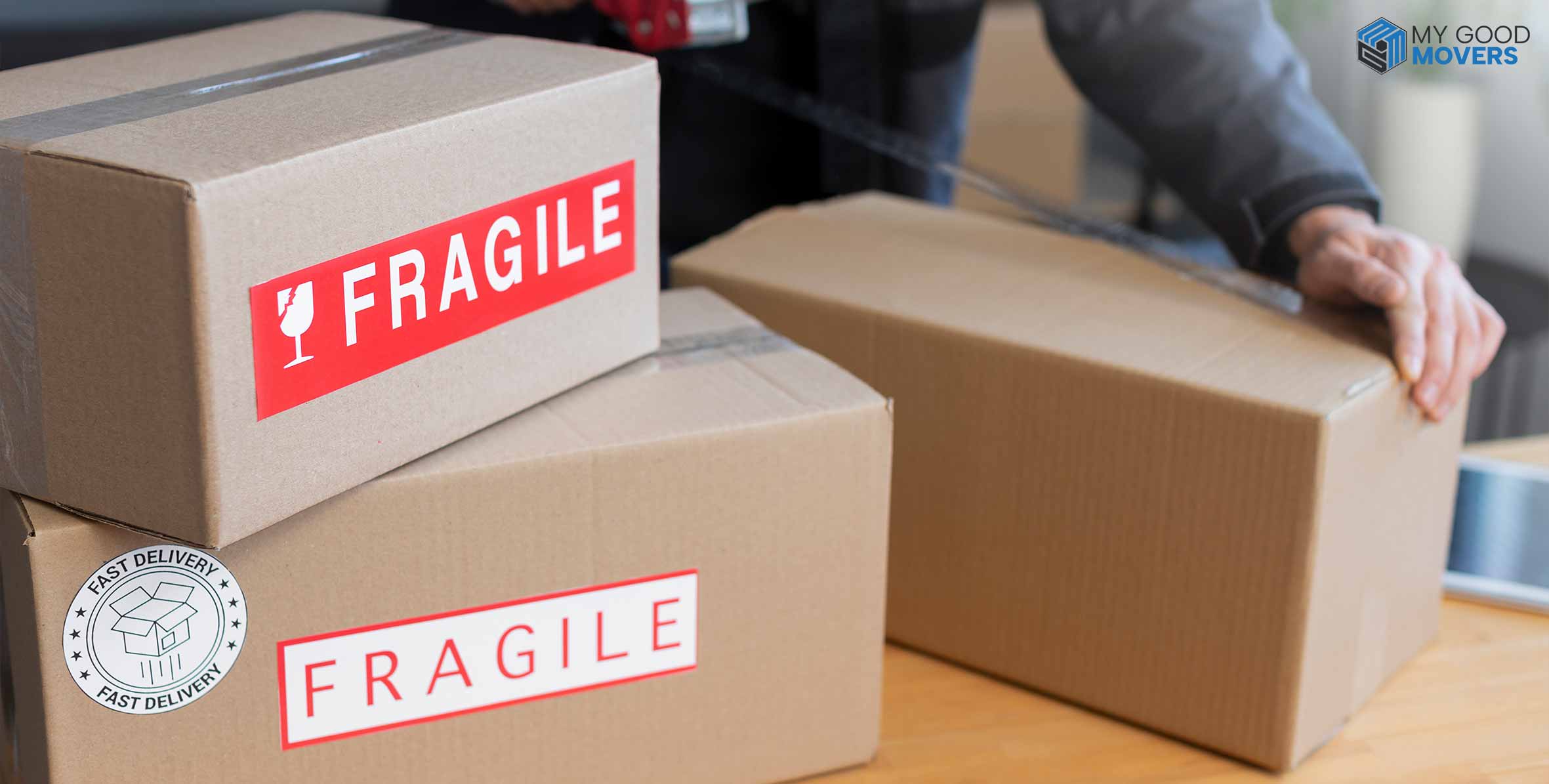Have you ever unpacked a box only to find your favorite vase shattered? It’s a frustrating experience that many people face when moving or shipping fragile items.
When it comes to moving or shipping fragile items, there’s no room for error. Did you know that nearly 20% of damage claims in the moving industry are related to improperly packed items?
Whether it's heirloom china, delicate glassware, or priceless collectibles, the right packing techniques are crucial to ensuring your valuables arrive safely.
So, how can you avoid such disasters and ensure your delicate belongings arrive in one piece? How to Pack Fragile Items? The trick is in the packing.
This blog will tackle common packing pitfalls and offer practical tips to keep your items safe.
Labeling and Handling Instructions for Fragile Boxes
Packing fragile items is only half the battle—proper labeling and handling are crucial for their safe journey.
Many of us have experienced arriving at our new home only to find our cherished glassware shattered because it wasn't clearly marked. How can you avoid this common mistake? The answer to “how to pack fragile items” lies in effective labeling and handling practices.
Labeling
Clearly, marking your boxes as "Fragile" is essential. Use fragile labels or stickers to indicate the delicate nature of the contents. You can also write “Handle with Care" on the box to emphasize the need for gentle treatment. Labels should be placed on all sides of the box to be visible from any angle.
Handling Instructions
Labeling the boxes alone is not enough; you also need to provide handling instructions. For example, use corner protectors and cushioning materials like bubble wrap or foam sheets to shield items from impacts. Clearly indicate on the box if it needs to be kept upright or handled with extra caution. Including instructions such as “Do Not Stack” can help prevent mishaps.
Curious about your moving costs? Fill out the details, and we’ll calculate them for you.

Visibility and Communication
Ensure that your handle with care instructions is easily visible. If you're using professional packing services, like those from Best Furniture Moving Companies, make sure they are aware of any special handling requirements. This will ensure that everyone involved in the move understands the importance of treating your fragile items with the utmost care.

Even small cracks or chips in glass items can worsen during a move, so they need extra cushioning to prevent shattering.
Essential Supplies for Packing Fragile Items
Using the right packing supplies helps cushion your belongings and minimize the risk of damage during transit.
Proper packing will avoid the heartbreak of finding your treasured items broken and ensure they arrive at your destination in one piece.
Here are some essential packing supplies for packing fragile items:
| Supply | Purpose |
|---|---|
| Cardboard Boxes | Basic containers for packing various items. Use double corrugated boxes for extra protection. |
| Packing Tape | Securely seals boxes to keep items in place. |
| Bubble Wrap | Provides cushioning for delicate items like glassware and mirrors. |
| Packing Peanuts | Fills gaps and prevents shifting inside boxes. |
| Foam Sheets | Adds a layer of protection for fragile surfaces. |
| Crumpled Packing Paper | Offers cushioning and prevents items from moving. |
| Corner Protectors | Shields edges and corners of picture frames and artwork. |
| Fragile Labels | Clearly marks boxes as containing delicate items. |
| Handle with Care Labels | Informs movers to handle the boxes gently. |
| Custom-Made Crates | Provides tailored protection for high-value items like artwork. |
| Rigid Containers | Offers strong protection for sensitive electronics. |
Step-by-Step Guide to Packing Fragile Items
Packing fragile items can be nerve-wracking, but with the right approach, you can keep your delicate belongings safe. Here’s a step-by-step guide to packing fragile items to ensure your items arrive in one piece:
- Gather Your Supplies: Start by collecting the necessary packing supplies—cardboard boxes, packing tape, bubble wrap, foam sheets, packing peanuts, and crumpled packing paper. Having the right materials on hand makes the process smoother and safer.
- Prepare the Box: Before placing any items inside, reinforce the bottom of the cardboard box with packing tape. For extra protection, consider using double corrugated boxes. Line the box with a layer of foam sheets or crumpled packing paper to create a cushioning base.
- Wrap Each Item Individually: For glassware, mirrors, picture frames, and other delicate items, wrap each piece separately using bubble wrap or foam sheets. Secure the wrapping with packing tape to keep it in place.
- Place Items in the Box: Carefully place the wrapped items in the box, starting with the heaviest and largest items at the bottom. Use packing peanuts or crumpled packing paper to fill any gaps, preventing movement during transit.
- Add Extra Protection: Insert corner protectors for artwork and mirrors. Consider using custom-made crates or rigid containers for particularly valuable or delicate items like sensitive electronics or artwork.
- Perform the Movement Test: Once everything is packed, gently shake the box. If you hear movement, add more cushioning materials, such as air pillows or inflatable packaging, to ensure everything is snug and secure.
- Seal and Label the Box: Seal the box with packing tape, label it with fragile labels, and handle it with care labels on all sides. This step is crucial to ensure that anyone handling the box knows to be extra cautious.
How to Avoid Damage When Packing Fragile Items
| Tip | Why It Matters |
|---|---|
| Choose the Right Box Size | A snug fit prevents items from shifting and breaking. |
| Invest in High-Quality Packing Materials | Sturdy materials like kraft paper and foam inserts provide better protection. |
| Group Similar Items Together | Keeps lighter items safe from being crushed by heavier ones. |
| Layer and Cushion Inside the Box | Adding layers reduces the impact of external shocks. |
| Use Rigid or Hard Plastic Containers | Provides extra protection for especially delicate items. |
| Opt for Temperature-Controlled Shipping | Maintains a safe environment for temperature-sensitive items. |
| Test the Box Stability Before Sealing | Ensures the packed items are secure and stable. |
| Seal with Care Using Packing Tape | Proper sealing prevents the box from opening accidentally. |
How to Pack Different Types of Fragile Items
Different fragile items need special packing methods to ensure they arrive in one piece. Picking the right materials and using the right approach for each item can save you a lot of headaches down the road.
| Fragile Item Type | How to Pack Them |
|---|---|
| Glassware | Wrap each piece individually with bubble wrap, fill the gaps with packing peanuts, and pack upright in double corrugated boxes. |
| Picture Frames | Use corner protectors, wrap in foam sheets, and place upright in a box with crumpled packing paper for cushioning. |
| Mirrors | Apply corner protectors, cover with foam sheets, and place in a box with sturdy dividers or custom-made crates. |
| Artwork | Wrap in acid-free packing paper followed by bubble wrap; use custom-made crates for high-value pieces. |
| Sensitive Electronics | Place in rigid containers with foam inserts for added protection, and seal tightly with packing tape. |
| Perishable Goods | Pack in temperature-controlled containers with ample insulation and air pillows to maintain freshness. |
| Document and Photographs | Store in acid-free folders and use rigid containers to prevent bending or damage. |

Mirrors can easily crack or break if not packed properly. Using corner protectors and wrapping them in foam sheets offers better protection.
Common Mistakes to Avoid When Packing Fragile Items
Packing fragile items is a delicate task, and it’s easy to make mistakes that could lead to damage. Here are some common mistakes and how to avoid them:
- Using Oversized Boxes: A common mistake is choosing boxes too big for the items. This can cause them to shift around during transit, increasing the risk of breakage. To avoid this, select a box that fits the items snugly, leaving enough room for protective materials.
- Skipping Cushioning Layers: Another pitfall is neglecting to line the box with cushioning materials. This layer is crucial for absorbing shocks. Always start by lining the box with foam sheets or packing paper before placing any items inside.
- Not Labeling Boxes as Fragile: Failing to label boxes properly is a sure way to invite trouble. Without clear fragile labels or handle with care labels, movers might not realize they need to be gentle. To avoid this, clearly mark all sides of the box.
- Overpacking the Box: Trying to fit too many items into one box is a recipe for disaster. Overpacking can lead to items pressing against each other, increasing the risk of damage. Instead, leave enough space for cushioning materials to protect the items.
- Neglecting to Secure Items Inside the Box: If items are not properly secured, they can move around and collide, leading to damage. Avoid this by filling any empty spaces with packing peanuts, foam inserts, or air pillows to keep everything in place.
- Using Weak Packing Tape: Skimping on packing tape can lead to boxes opening during transit. It’s important to use high-quality packing tape to properly seal the box and ensure it stays closed.
Hiring a Moving Company to Pack Fragile Items
When packing delicate items, hiring a moving company can make a big difference. Professionals know how to pack fragile items properly and use the right materials to keep them safe.
This can save you time and relieve some stress. If you need help, look into Moving Labor—Affordable and Safe Moving Solutions Near You to ensure your items are packed and moved with care.





